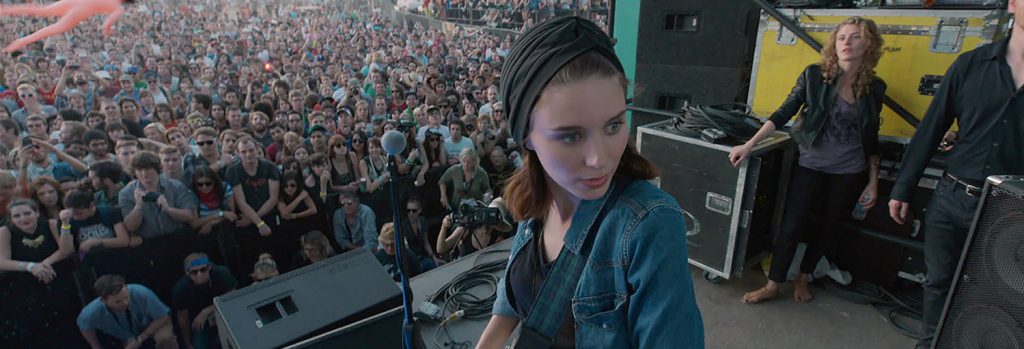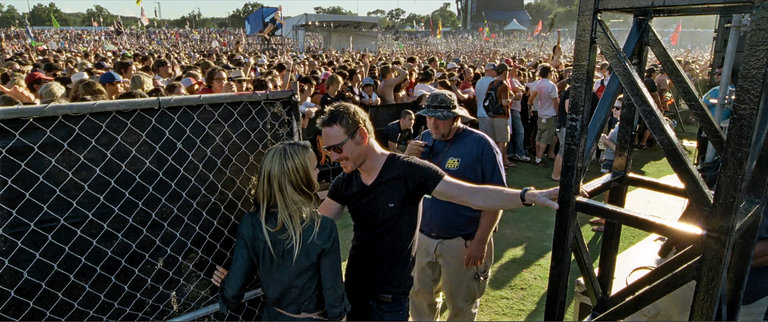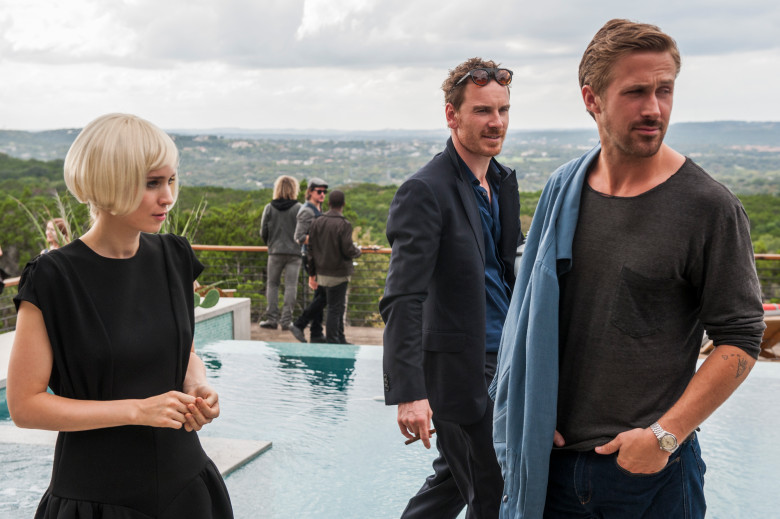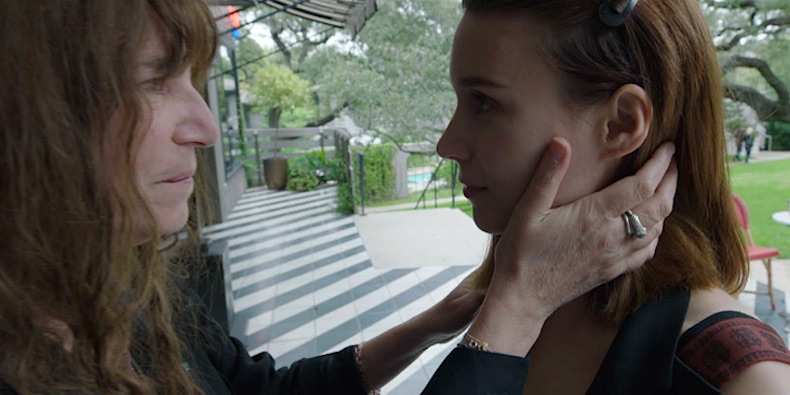Alex writes about Terrence Malick’s Song to Song.
Below is a list of questions I silently posed to myself amidst the running time of Song to Song:
- Was Val Kilmer actually supposed to be in this film, or did he merely show up and jump in front of the camera?
- Does Ryan Gosling exclusively portray struggling musicians now?
- Is this movie being told chronologically? How much time does this movie cover?
- Why are people eating sushi off of Rooney Mara?
- Do I hate this movie?
Now to answer the most salacious, obvious premise-setter of a question that was the fifth query in that list: no. I do not hate Song to Song. But there was a time during its runtime when I was concerned I might, and that idea alone was frightening enough. (And now that the premise has been set in an appropriately obvious manner, we may continue.)

I am a Terrence Malick superfan. As film fans have seemingly given up on him in reaction to his post-The Tree of Life output, I have only more thoroughly begun to admire Malick’s attempts within his wandering style. Last year’s Knight of Cups was exceptional even by Malick’s own standards, although admittedly his previous release To The Wonder being definitively not spectacular. To The Wonder was an enjoyable muse on Malick’s inner quandary about returning to America from his new world in Paris, sure, but it mostly fell apart because two of the three leads were not compelling in the Malickian cinematic universe. Neither Rachel McAdams nor Ben Affleck were as comfortable in Malick’s world as The Tree of Life’s Jessica Chastain and Brad Pitt, so their respective characters came apart as scraps of people as opposed to feeling like fully formed, comfortable humans*. This was not entirely the fault of McAdams nor Affleck, but it became the defining fault of the film.
*It is here where I will note that Olga Kurylenko was quite good in To The Wonder.
It is difficult to give a good performance in a Terrence Malick film for myriad reasons, but the primary one is a continual lack of preparation time. When on set with Malick, work is notoriously improvisational, something I would imagine has only increased as Malick’s crews embraced digital cinematography. Sometimes actors will have no idea what their job will be on a given day; Malick has been known to be driving to set, see a location he wants to shoot in, and demand the production van stop to shoot something that just came to mind. He will whisper* a brief idea to them that is basically nonsense – for example, “Look at the sun like you can’t fathom the beauty of this world” – and the actor in question is forced to navigate that thought within the interior world of their character they have built for themselves. In order to do this, you have to have both fully created your character internally and be able to improvise within it, which appears to be difficult for many (the aforementioned McAdams and Affleck, Rooney Mara, Sean Penn, Christian Bale, among others). It sometimes feels like you have to already embody the type of person Malick wants you to play in order to give the type of performance his movie needs; being a convincing actor is difficult enough without prep time, so it seems one has to already embody core characteristics of a Malick character in order to successfully perform as one. Par example, Jessica Chastain appears to be a very loving person who seems like she would genuinely be a fantastic, caring mother; ipso facto she gives the best performance of her career in The Tree of Life, a performance that in turn carries the movie.
*I say whisper because that is – almost without exception – how actors describe getting instructions from him.
The reason it matters so much that Malick’s performers naturally occupy a similar space to their characters is certainly because Malick gives them so little to work with, but as an audience he often gives us even less. Narrative details are sparse in this world. Watching a modern Terrence Malick film becomes a gorgeous Rorschach test where you are forced to stare at archetypical scraps of characters and reflect on your own life; if you are willing to look, you might see something you identify with, but if not you might walk out by the twenty-five minute mark*.
*Last year I arrived thirty minutes early for a late night screening of Batman v. Superman: Dawn of Justice and realized I could see the beginning of Knight of Cups again to kill time before the superhero squalor. By the time I left Baleman for Batman twenty minutes in, four people had walked out. I do not fault them.
Now, I recognize this is an apologist’s description of Terrence Malick’s films. If somebody said that to me about Gus Van Sant or Lars von Trier or Mark Vun Bard it would take every ounce of my soul to not spit on their shoes. It sounds hacky, I know, like I can’t come up with a better answer for why I like Malick’s films. And it is. I fully recognize this. Malick turns me from a thoughtful person into somebody willing to engage with scraps of people and thoughts simply because he gives me something to project my own life onto. Which is simultaneously what everybody wants from their art and something nobody can vocalize without sounding like that idiot in the coffee shop who is talking a little too loudly. But this is simultaneously the problem with Malick and precisely what makes him great. He devolves my critical voice into blabbering mush about the grace of the natural world, even to the point where I don’t hate myself for writing the first half of this sentence.
Let’s go back to my above question: do I hate this movie? As I was sitting in Song to Song, about two-thirds of the way through I was feeling the way most people seem to feel sitting through a modern Malick film. I was getting almost nothing out of it other than consistently gorgeous cinematography and a casually charming Ryan Gosling performance. In short, I kind of felt how most viewers seem to feel about Malick’s post-Tree of Life output. I wrote about all this in detail a year ago, but it seems even more clear to me as seemingly even more people have (judging by the reaction to Song to Song at least) given up on Malick, this just so happened to be the first time I was personally experiencing said feeling. And then, very near the end of the picture, something changed. I found myself leaving my previous thoughts behind, because I had suddenly found too much to like in Song to Song.
A day after the screening, I tried to parse this conundrum with a friend: if the journey to the ending is trying, can a good close elevate a piece of art from bland to good? I would say the answer is obviously yes, while others might claim that you are simply being fooled, being caught in the midst of the Whiplash effect. Again, midway through Song to Song, I legitimately questioned whether or not I hated this film. This has never happened to me with another Malick film, because I love Malick films so deeply that I have watched even To The Wonder on four separate occasions. So the question of why this happened seemed worth pondering.
I am a decisive man. I do not waffle; my freezer is sans Eggos. As such, if I were to ever meet the real life equivalent of a post-Tree of Life Malick character, I would almost certainly despise them. All they do is walk around, touch walls, and have wholly non-committal conversations. They’re not even shitty people necessarily, just so outwardly sensitive that spending any time with them would have to be an absolute nightmare. They all want to talk about their feelings and be in love triangles and move from Paris to America and that is all tremendously boring to me. But something about these pictures draws me in nonetheless.
As mentioned earlier, the characters in these films are archetypes. People in Malick films are not fully formed characters with backstories pre-written for the actors to absorb; Terrence Malick decidedly does not take the Michael Mann approach to pre-production. They are sketches, frequently sketches that are redrawn over and over throughout the course of two hours, sketches that never fully get completed. As such, when I describe all the pertinent details in the following paragraph, they will sound silly. This is unavoidable. But Terrence Malick must make you feel silly before he makes you ponder your own existence, so this is how it must go.
In Song to Song, the archetypes we are given are musicians, a capitalistic artist, an aspiring teacher, or Cate Blanchett. Rooney Mara and Ryan Gosling spend most of the movie being an uninspiring musical couple, and music producer Michael Fassbender tries to seduce one or both into a record deal and/or bed and/or a timeshare on the outskirts of Austin that has a fabulous pool situation. (Not only are motives unclear in Malick’s world, so are actions themselves.) When Fassbender meets a waitress played by Natalie Portman – a waitress who would be a teacher if there were enough scholastic jobs to be had – Fassy becomes enamoured with her. That’s pretty much it; the rest of the movie is primarily very gorgeous people very gorgeously wandering.
Fassbender’s character quickly becomes the most fascinating of our sketches, because he is the one who is the catalyst for the way the film discusses art. Mara and Gosling are musicians – Gosling specifically is one who believes he should make his music on his own – while Fassbender is the producer, and a seemingly successful one at that. (Again, his chosen abodes are pretty fucking amazing.) But his seduction of – no hold on one second.
See, this is where I was going to write, “But his seduction of Gosling appears to be a negative for the Gos’ existence, and the same can eventually be said for Mara. Fassbender lures them into a world outside their own and temporarily destroys the good things they already had.” That is a tremendously stupid and obvious statement (even apart from my gross overuse of the word “but” throughout this essay). The glorious thing about Malick is that he can make you feel these things without necessarily spelling them out; since so few pick up what he is putting down though, I feel compelled to explain what I get out of it. If I sound like an idiot, so be it. As long as I nail the conclusion, hopefully you’ll think about what came before it in a different light.
As the movie progresses, Portman becomes more drawn into Fassbender’s world, a world outside her own. Late in the film, Malick cuts between a scene of Portman’s mother draping water on Portman’s face and Fassbender dousing two naked paramours with a showerhead. And then, we see Portman in entirely different waters. She got too deep into one world, too far away from one she should have never left, and she loses her life in the process.
Song to Song is a film primarily set in Austin, and much of the movie shows the cityscape and a variety of musicians performing at the Austin City Limits festival. Malick is not a Texan by birth, but he went to school in Austin as a youth and (as far as anybody can tell) is currently residing there.
Austin is a city of growth; you can’t remember how people thought about Austin in 1990 because people didn’t really think about it at all. It was mostly where the Longhorns were based. This perception of the city has changed, as it is now an artist’s hub, a city that seemed pretty cool from the outside, and a city I had at the top of the list of a comically short list of cities I was actually willing to make an effort to travel to.
James and I were in Austin this past January. After a comically large tray of barbecued meats and beige sides and giant orange sodas that was then replenished with another comically large tray of barbecued meats and beige sides and giant orange sodas, our server Layla began discussing the feeling of growing up in Austin in the 1990s and seeing what the city turned into.
“It used to be a small, lazy place where nobody wanted to come to, and now everybody wants to travel here.” This is not a direct quote because by this point I was at least 80% sure I would be dead within the next forty-five minutes so I was contemplating my pending demise, but I’m confident something of the sort was said by a woman in cowboy boots. Layla then casually mentioned being a fan of the Deftones and offered us refills of our giant orange sodas for the walk home, as people in America always want you to have more orange soda.
It felt like Layla meant her comment about Austin’s growth in a positive fashion; if she didn’t it would have been a direct dig at us, and Layla did not seem like the type of person to insult two travelers to their faces. Watching Song to Song though, I don’t necessarily think Terrence Malick would agree with her.
Gosling and Mara are musicians who are attempting to be unaffected by the constructions of the music industry, while Fassbender is continually trying to lure them into those same constructions so that he can profit from them (albeit to the detriment of his own life*). The use of music festivals only exacerbates this idea; somebody had to profit on all those fucking wristbands Rooney Mara is wearing. Song to Song depicts Austin’s growth alongside the capitalization of art, a sort of growth that is eventually depicted negatively, because nobody wants Natalie Portman to die.
*Knight of Cups is also very much about this same thing happening to Christian Bale in the film industry. If Bale had played Fassbender’s character here, as seems to have been the initial plan, the films probably would have felt almost hilariously similar.
Watching the film a second time, my initial qualms about potentially hating Song to Song never returned from dormancy. I enjoyed the journey to the conclusion more, and I began to think about the film in a more abstract way. It became clear to me that Portman and Mara might not even be playing entirely different characters; given their mild physical likeness and general theme of corrupted innocence, I started to look at them as alternate timeline versions of each other*. To this end, Mara feels like the character we’re supposed to believe exists, while Portman represents Mara’s fears of what could happen if she plunged too deeply into the wrong existence.
*It is worth noting that we see Mara’s father but not mother, just like we see Portman’s mother but not father. Mara and Portman are each one half of a whole.

When I was in Austin, I spent a lot of time pondering what I wanted my life to be, and specifically where I wanted my life to be set. Outside of the convenience of many local, long-lasting friendships and a stellar movie theatre situation, I have never been particularly attached to the city I have called home for seven years. Over the past couple of years, however, was the first time I ever truly considered leaving it. There are few non-dramatic options that could be grasped, and each one of those seems unappealing for various reasons. As with anybody thoroughly enjoying their vacation, I briefly considered attempting to move to Austin, but switching countries would require far too much work that I am not willing to do (not to mention becoming a part of the Austin problem to Malick, a man whom I never want to offend). I am not concerned about being corrupted and Portmanized by my surroundings; I am an incorruptible person who has built his life around almost never having to do what others tell him to. As such, not being confident about where I have wanted my life to continue made me feel like a Malick character I would surely despise.
As mentioned earlier, Malick went to school in Austin, a city he eventually moved back to much later in life. I’m sure if cornered into answering the question, Malick would self-identify as a Texan. This is certainly the feeling Song to Song gives. He departed to Paris for decades, before returning to America and then eventually Austin itself. Malick left to find something he was unsure existed, but he fled nonetheless. In what is a hilariously Malickian truth, when he came back to America in the 1990s while in his fifties, he married his high school sweetheart. He ended up back where he began.
Song to Song is a circular narrative of sorts. As mentioned in my opening, I have no idea what the chronology of this film is supposed to be, nor do I think knowing that would make the film better (I’m confident it would make it worse). What I think one is supposed to grasp, however, is the circularity of the narrative. At the beginning of the film, Mara is at an Austin bar bouncing around and talking to various people while seemingly waiting for somebody to perform or listening to somebody perform, I don’t entirely recall. Toward the end of the film, we see her back in the same location on what seems to be an entirely different day, with an entirely different outfit and hairstyle. The next scene of the film is the concluding one.
I haven’t written about Gosling’s character much, partially because his counterpart Fassbender is more interesting but mostly because the thematic elements of Gosling’s character that matter also mostly exist in Mara. Gos is continually encouraged to move back home throughout Song to Song, and when he eventually does return he starts working on an oil rig or whatever. This detail hardly matters; all that matters is the sparseness of the locale surrounding him.
The last scene of the film is Mara and Gosling returning to a place we have seen them previously, some sort of rocky hill type thing, where they can gallivant and kiss and whisper monologue to each other forever. There is no physical manifestation of modern society around them at all; they are merely surrounded by the natural world, together with nothing to corrupt them. They saw the world that existed, and decided they had enough of it, and came back to live a simpler existence together.
This seems like a slightly defeatist conclusion. You can see where it came from for somebody like Malick who is notoriously reclusive, but I can’t imagine it for most people. I get the idea of leaving a place you feel is broken, but simply retreating from everything outside of what you already knew does not seem like a solution I’m comfortable with. I am, however, willing to accept that I will feel differently in forty years.
As my second screening of Song to Song closed, a woman behind me with a broken leg said to her partner, “That movie felt like somebody writing in a journal.” This writer’s oversized ears have never heard a better description of Malick’s work.
I wrote a long essay about Malick’s career about a year ago when Knight of Cups was released. I have not re-read that piece since I finished it, but I can only imagine the crux of the argument remains the same as what I’m peddling here. Malick movies make me feel like no other auteur’s films can, and that has to mean something. But I’ll never be able to fully capture it with words, because so much of what Malick does is wordless. Most filmmakers I adore embrace a cautious display of their emotions and calculate their stories into a more oblique, structured representation of them. Malick doesn’t give a fuck about that. He comes up with the simplest of narratives and projects his feelings upon it, choosing not to display the actions that propel the narrative of a life so much as the thoughts that exist in between the actions. His characters are constantly in flux because he cares not for stasis. But even he seems willing to give up on this wandering style; while discussing Song to Song at South by Southwest this year, he claimed to be returning to a more traditionally scripted style, retiring what we have come to know as Malickian. Even the perpetual wanderer finds comfortable stasis eventually.
When I was discussing the boredom I felt during my initial viewing of Song to Song, I meant it, just like I meant it when I said the end of the film made me reconsider all that came before it. It simultaneously ended up back where it began and made the journey worth going through to get to what was ultimately a simplistic concluding point.
“This. Only this.” Perhaps one day.






